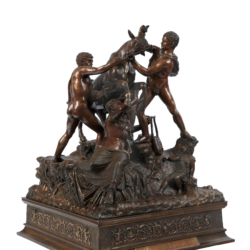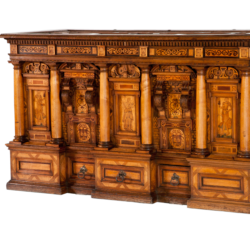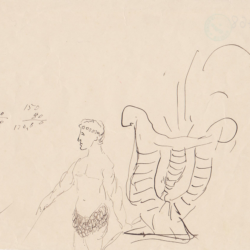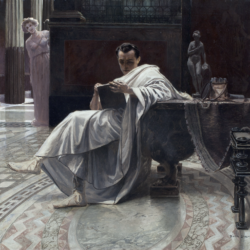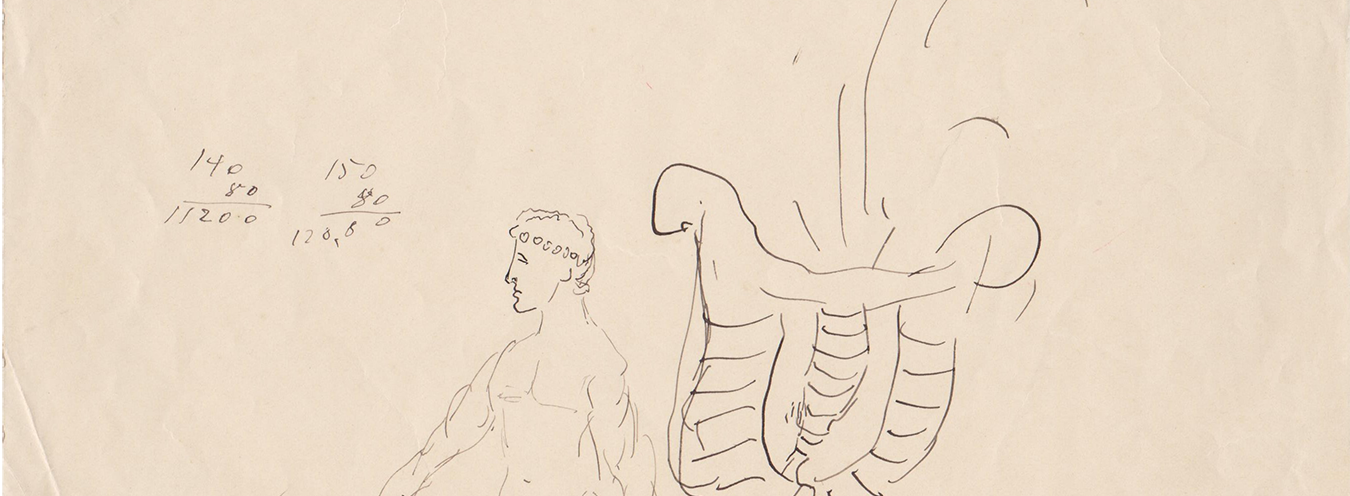
Greek Element and Transgression
Sienkiewicz’s legend Na Olimpie (On Mount Olympus), published in 1900, describes “a crowd of gods, deserted, forgotten, scared and waiting for a death sentence,”[1] among whom only the Song (Apollo) and Happiness (Aphrodite) are going to be saved.[2] As Józefat Nowiński wrote in 1901, “As the saying goes, there is a grain of truth in every joke, and that is why I believe that, as a poet, Sienkiewicz slightly regrets such beautiful gods as Apollo and Venus or such lovely goddesses as the Muses.”[3] Indeed, we can believe in Sienkiewicz’s regret concerning the Greek gods and the ideals of pure beauty that they evoke. Are the consecutive literary versions of the herculean theme – the legendary demigod, half-man, wanted like a charity by the hungry-for-heroism nation – the forms of this longing? In order to confirm the significance of the antique version of heroism in the writer’s imagination, we may add that Sienkiewicz is the author of a drawing that represents the hero’s head with a lyre.[4]
The recurrent 19th-century discussion on the semantics of antique art supported the growth of Sienkiewicz’s above-mentioned sensitivity towards disintegration and transformations of the heroic myth (as far as Polish authors are concerned, we can quote, for instance, Euzebiusz Słowacki or Józef Kremer[5]). In his monumental work on the history of artistic imagination, Kremer pointed out to mythological Hercules as a peculiar harbinger of new sensitivity connected with the influence of Christological ideal:
In this old herculean myth, you will find both the heavenly and the earthly element, and the triumphs of the soul over sexual urges; here, you will see good matter, the body shining with a soul, the image of a man coming to grips with the hardships of life, fighting for eternal glory. All this is just a dream of an early, still unawake, human history. There are specters of new life that was to be born in the history of the world! These are the prophecies of the salvation of all people, still closed in a bud of God’s flower![6]
What is interesting, the author of the aforementioned drawing, which represented the hero with a lyre, the creator of the ambiguous and subtle figure of Petronius, whose physique includes many womanly features, did not show empathy to Octave Feuillet, a French author contemporary to Sienkiewicz. Against Feuillet’s drama, entitled Le Sphinx, in 1874 Sienkiewicz juxtaposed a completely different model of artistic work in the Niwa a magazine, evoking the heritage of Hellas – but Sienkiewicz clearly emphasized its “manly” aesthetic and cognitive horizon:
On the contrary: the brave, harsh, manly soul will reject such art that weakens hearts, softens conventions, makes minds effeminate, easily intoxicates like a drug, but also weakens like a drug. The one who needs Tyrtaeus for the needs of their public will despise Feuillets. Feuillet forgot that apart from a woman, the physiology of her biological needs, the love affairs of the salons, apart from the unnatural passions and sophistication of the decay, there is another world: broad, clear, airy, with the shining sun, moon, and stars. Could he not hear the sounds of this other world? Could he not hear the swoosh of the sea, the winds and the forests, and sometimes the battle cries, the trills of the nightingale or the shepherd’s pipe?[7]
In his discussion with Feuillet, Sienkiewicz contrasts the “manly” poet, Tyrtaeus, with the despised softness, physiology, and effeminacy of the art.
A similar note could be heard in his 1905 polemics with Anatol France, whose Hellenism is believed by Sienkiewicz the journalist to contrast with the Christian perspective, and whose aestheticism (in Petronius’ style) seems to smack of moral indifference:
However, Anatol France fails to appreciate, limits and purposefully diminishes Christianity. And it is a pity. It is a pity even from the artistic and literary point of view, not to mention all other aspects. By doing so, he ceases to be this cheerful Greek skeptic, this child of merry, chatty and humorous Hellas, this Pyrrhonian butterfly, hovering on the colorful wings above all signs of life. His works cease to be a sweet pastime, literary delight since their author becomes the man of a party, the member of a faction or even of a sect, a short-term politician, a Dreyfusard, the supporter of Combes and whoever you want – but not himself. And, primarily, by smuggling a certain tendency in a seemingly neutral form, he loses artistic honesty, which was his main asset, and which, next to his talent, wit, and creative and extremely vivid thought, ensured his popularity in France and in other countries. Finally, it is a pity also because he seems to be a bit of a modern Petronius. He cannot stand evil, violence, ignorance, barbarity, and cruelty – both because he has a noble soul and because, as an aesthete, he despises all ugliness.[8]
Petronius, who was presented by Sienkiewicz in such an ambiguous and seductive way in Quo Vadis, becomes in this literary polemics argumentum ad hominem, slightly depreciative and embarrassing the opponent. But in this article, Sienkiewicz says something that is important for him – he claims that literary Hellenism is a bit of an escape from the world, an aesthetic pleasure, liberation from the strict discipline of “tendency.” Is this the reason why the writer sketches “the head of the hero with a lyre,” next to other (contemporary) male and female heads?
Przypisy
- Dzieła [The Collected Works], vol. 5, p. 141.
- See the interpretation of Na Olimpie (On Mount Olympus) presented by Aneta Mazur, where “a similar poetic vision of religious symbiosis conveys a completely different (because) Christian message. It brings saints down to earth and puts earthly values in the sphere of the sacred” (A. Mazur, Transcendencja realistów. Motywy metafizyczne w polskiej i niemieckiej prozie II połowy XIX wieku [Transcendence of the realists: Metaphysical themes in Polish and German fiction of the second half of the 19th Century], Opole 2001, p. 306). Earlier, Andrzej Stawar described the legend Na Olimpie as “an interesting commentary to Quo vadis” (A. Stawar, Pisarstwo Henryka Sienkiewicza [The works of Henryk Sienkiewicz], Warsaw 1960, p. 287).
- J. Nowiński, Sienkiewicz, Warsaw 1901, p. 155.
- See Bibliografia Literatury Polskiej „Nowy Korbut”. Henryk Sienkiewicz [Bibliography of Polish literature “Nowy Korbut.” Henryk Sienkiewicz], edited by. D. Świerczyńska, Warsaw 2015, p. 621.
- In his Teoria poezji [Theory of poetry], Euzebiusz Słowacki quoted Jacques Dellile: “Developing all his poetic power, Homer shows me the ancient Hercules in his soft beauty” (E. Słowacki, Dzieła z pozostałych rękopismów ogłoszone [The works published from the remaining manuscripts], Wilno 1026, p. 171; emphasis M. R.) Commenting Hercules’ Labors, Kremer noted that “What was harder than all those labors was the suffering that Hercules endured, giving himself to the humiliating servitude, and the voluntary obedience meant humiliation of his goodness” (J. Kremer, “Listy z Krakówa” [Letters from Kraków], vol. 1; Wstępne zasady estetyki [Preliminary principles of aesthetics] and Dzieje artystycznej fantazji [The history of artistic imagination], vol. 1, Warsaw 1877, p. 43; emphasis: M. R.).
- J. Kremer, op.cit., p. 44.
- Dzieła [The Collected Works], vol. 45, p. 251.
- Dzieła [The Collected Works], vol. 46, pp. 76–77.

